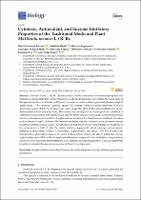Por favor, use este identificador para citar o enlazar este ítem:
https://repositorio.usj.es/handle/123456789/451
Registro completo de metadatos
| Campo DC | Valor | Lengua/Idioma |
|---|---|---|
| dc.contributor.author | Taviano, Maria Fernanda | - |
| dc.contributor.author | Miceli, Natalizia | - |
| dc.contributor.author | Acquaviva, Rosaria | - |
| dc.contributor.author | Antonio Malfa, Giuseppe | - |
| dc.contributor.author | Ragusa, Salvatore | - |
| dc.contributor.author | Giordano, Deborah | - |
| dc.contributor.author | Cásedas, Guillermo | - |
| dc.contributor.author | Les Parellada, Francisco | - |
| dc.contributor.author | López Ramos, Víctor | - |
| dc.date.accessioned | 2021-02-09T13:27:07Z | - |
| dc.date.available | 2021-02-09T13:27:07Z | - |
| dc.date.issued | 2020-07-13 | - |
| dc.identifier.citation | aviano, M.F., Miceli, N., Acquaviva, R., Malfa, G.A., Ragusa, S., Giordano, D., Cásedas, G., Les, F., López, V., 2020. Cytotoxic, Antioxidant, and Enzyme Inhibitory Properties of the Traditional Medicinal Plant Matthiola incana (L.) R. Br.. Biology 9, 163.. doi:10.3390/biology9070163 | es_ES |
| dc.identifier.issn | 2079-7737 | es_ES |
| dc.identifier.uri | https://repositorio.usj.es/handle/123456789/451 | - |
| dc.description.abstract | Matthiola incana(L.) R. Br. (Brassicaceae) is widely cultivated for ornamental purposes andutilized as a medicinal plant. In the present work, the hydroalcoholic extract from the aerial parts ofthis species has been evaluated in different bioassays in order to detect potential pharmacologicalapplications.The cytotoxic capacity against the human colorectal adenocarcinoma (CaCo-2)and breast cancer (MCF-7) cell lines was tested using the MTT (3-(4,5-dimethylthiazol-2-yl)-2,5-diphenyltetrazolium bromide) assay. The extract was investigated as a neuroprotective inhibitor ofcentral nervous system (CNS) enzymes such as monoamine oxidase A, tyrosinase, acetylcholinesterase,and as a natural enzyme inhibitor ofα-glucosidase and lipase involved in some metabolic disorderssuch as obesity or type 2 diabetes. The antioxidant ability was also evaluated in an enzymatic system(xanthine/xanthine oxidase assay). Results showed that theM. incanaextract displayed moderate tolow cytotoxicity vs. CaCo-2 cells. The extract acted as a superoxide radical scavenger and enzymaticinhibitor of monoamine oxidase A, tyrosinase,α-glucosidase, and lipase. The best results werefound in theα-glucosidase assay, asM. incanahydroalcoholic extract was able to inhibit the enzymeα-glucosidase up to 100% without significant differences, compared to the antidiabetic drug acarbose.Matthiola incanahas been demonstrated to exert different biological properties. These are importantin order to consider this species as a source of bioactive compounds | es_ES |
| dc.format.extent | 12 p. | es_ES |
| dc.format.mimetype | application/pdf | es_ES |
| dc.language.iso | eng | es_ES |
| dc.publisher | MDPI | es_ES |
| dc.rights | Atribución 4.0 Internacional | * |
| dc.rights.uri | http://creativecommons.org/licenses/by/4.0/ | * |
| dc.subject | Anti-glucosidasa | es_ES |
| dc.subject | Antioxidante | es_ES |
| dc.subject | Plantas medicinales | es_ES |
| dc.subject | inhibidor de la enzima | es_ES |
| dc.subject | Polifenoles | es_ES |
| dc.subject | Flor común | es_ES |
| dc.subject | Brassicacea | es_ES |
| dc.title | Cytotoxic, antioxidant, and enzyme inhibitory properties of the traditional medicinal plant matthiola incana | es_ES |
| dc.type | info:eu-repo/semantics/article | es_ES |
| dc.subject.unesco | Planta medicinal | es_ES |
| dc.identifier.doi | 10.3390/biology9070163 | es_ES |
| dc.rights.accessrights | info:eu-repo/semantics/openAccess | es_ES |
| Aparece en las colecciones: | Artículos de revistas | |
Ficheros en este ítem:
| Fichero | Descripción | Tamaño | Formato | |
|---|---|---|---|---|
| Cytotoxic, antioxidant, and enzyme inhibitory properties of the traditional medicinal plant matthiola incana.pdf | 1,55 MB | Adobe PDF |  Visualizar/Abrir |
Este ítem está sujeto a una licencia Creative Commons Licencia Creative Commons

